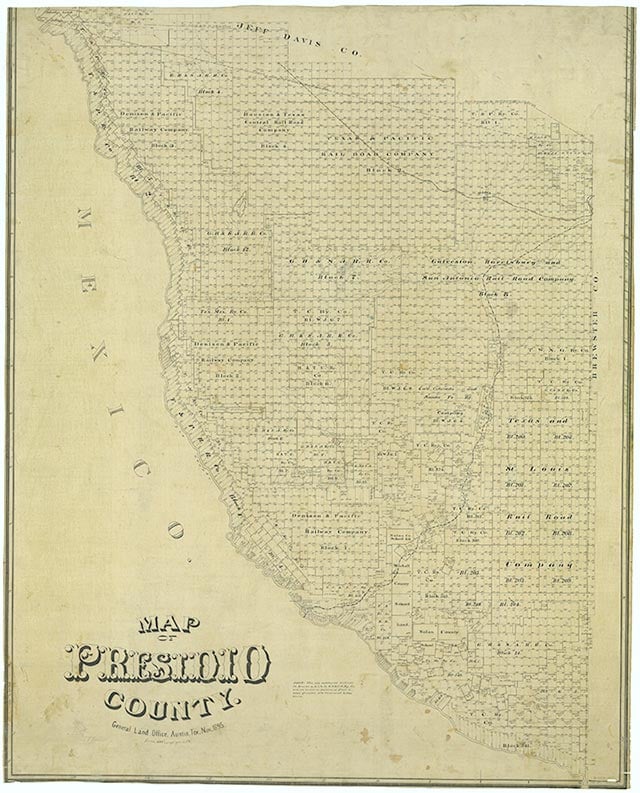Shafter

Shafter is on Cibolo Creek and U.S. Highway 67, at the east end of the Chinati Mountains eighteen miles north of Presidio in southern Presidio County. Its history is closely tied to silver mining. There is evidence that the Spaniards prospected for valuable ores in the area during the early 1600s, but Shafter became a mining town only after September 1880, when John W. Spencer, a freighter turned prospector, found silver ore there. Spencer showed an ore sample to Col. William R. Shafter, commander of the First Infantry Regiment at Fort Davis, who had it assayed. When small amounts of profitable silver were found, Colonel Shafter interested two army friends, Lt. John L. Bullis of the Twenty-fourth Infantry and Lt. Louis Wilhelmi of the First Infantry, in a land deal on the acreage surrounding Spencer's strike. In October 1880 Colonel Shafter and his partners asked the state to sell them nine sections of school land in the Chinati Mountains near the site of Shafter. Colonel Shafter requested two sections in his name and two in his wife's. Wilhelmi filed for three sections. Because Bullis already owned many acres of West Texas land in his name, he applied for two sections in his wife's name. Though the three partners petitioned for the land individually, they verbally agreed to make Spencer a partner and to share equally the profits earned from the acreage. In January 1881 Wilhelmi bought two sections of the nine for which the partners applied. At the same time, Bullis purchased the two sections he requested in the name of his wife. The other five sections were not purchased. Even though the partners owned four sections with potential silver deposits, they lacked the capital and the technical expertise to mine the ore. In June 1882 they leased some of their acreage to a California mining group which, in late summer 1883, organized the Presidio Mining Company and contracted individually with Shafter, Wilhelmi, and Spencer to buy their interests. Each received 5,000 shares of company stock and $1,600 cash. At the same time the manager of the company, William Noyes, found silver deposits on the acreage, valued at $45 per ton. The silver deposits found by Noyes were on one of the two sections owned by Bullis's wife, and Bullis refused to sell. He claimed that the two sections had been bought by his wife with inherited family money and were not his or his partners' property. He secured a court injunction to stop mining on that section, but the company continued work in the other sections. When the injunction expired in the spring of 1884, the Presidio Mining Company resumed operations in the productive Bullis section. The company hired more workmen and installed milling machinery.
The town of Shafter, located near the Presidio Mine and named for William R. Shafter, developed with the increased milling operations. A post office was opened in Shafter in 1885. Though the Bullises sued to retain their interest in the land and a lower court ruled in their favor, the Presidio Mining Company won a decision in 1887 before the Texas Supreme Court. Freed from litigation, the company stepped up its operations as Noyes hired nearly 300 men to work the mine. Workers in the Presidio Mine at Shafter came from several ethnic groups and geographical areas. Mexican citizens and black Americans found better-paying jobs there, and miners from California worked at Shafter until they left to prospect for Alaskan gold in 1897. Shafter miners lived in company houses, shopped at the company store, and received medical care from the company doctor. Just after 1900, Shafter had a population of 110 and two saloons, a dance hall, and a school. During the 1920s and 1930s the Shafter mine closed and reopened several times. In 1928 the Presidio Mining Company sold the mine to the American Metal Company, but there was little change to the mining operation. In 1942, with increased production costs and a shortage of miners, the mine closed again, but by 1943 Shafter had a population of 1,500; at that time it also had twelve businesses that served the military population that was stationed at two bases in the county. After Marfa Army Air Field and Fort D. A. Russell closed, the population of Shafter declined, reaching twenty by 1949. Though from the 1950s through the 1970s several attempts were made to reopen the Presidio Mine at Shafter, the town and the mines remained deserted. The original town site, designated the Shafter Historic Mining District, was added to the National Register of Historic Places in 1976.
Julia Cauble Smith | © TSHA

Adapted from the official Handbook of Texas, a state encyclopedia developed by Texas State Historical Association (TSHA). It is an authoritative source of trusted historical records.

- ✅ Adoption Status:
- This place is available for adoption! Available for adoption!
- Adopted by:
- Your name goes here
- Dedication Message:
- Your message goes here
Belongs to
Shafter is part of or belongs to the following places:
Currently Exists
Yes
Place type
Shafter is classified as a Town
Location
Latitude: 29.82017330Longitude: -104.30325320
Has Post Office
No
Is Incorporated
No
Population Count, 2009
57
